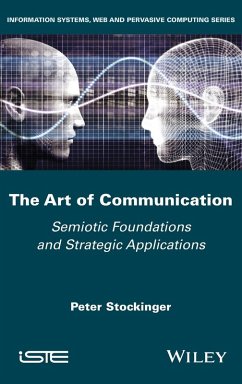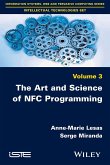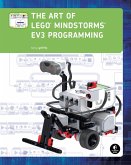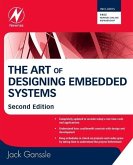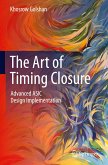- Gebundenes Buch
- Merkliste
- Auf die Merkliste
- Bewerten Bewerten
- Teilen
- Produkt teilen
- Produkterinnerung
- Produkterinnerung
The Art of Communication combines over two decades of research and teaching into a comprehensive guide on strategic communication. Grounded in the theoretical and methodological frameworks of 'situated communication' and 'communication project', this book highlights an understanding of both traditional and emerging communication practices. It particularly focuses on new genres, such as branding, design and digital communication strategies, and introduces the innovative concept of 'textscapes' - specially crafted environments to fulfill communicative objectives. This book is enriched with…mehr
Andere Kunden interessierten sich auch für
![The Art and Science of Nfc Programming The Art and Science of Nfc Programming]() Anne-Marie LesasThe Art and Science of Nfc Programming159,99 €
Anne-Marie LesasThe Art and Science of Nfc Programming159,99 €![The Art and Science of Ultrawideband an The Art and Science of Ultrawideband an]() Hans SchantzThe Art and Science of Ultrawideband an103,99 €
Hans SchantzThe Art and Science of Ultrawideband an103,99 €![The Art of Lego Mindstorms Ev3 Programming The Art of Lego Mindstorms Ev3 Programming]() Terry GriffinThe Art of Lego Mindstorms Ev3 Programming26,99 €
Terry GriffinThe Art of Lego Mindstorms Ev3 Programming26,99 €![The Art of Designing Embedded Systems The Art of Designing Embedded Systems]() Jack GanssleThe Art of Designing Embedded Systems58,99 €
Jack GanssleThe Art of Designing Embedded Systems58,99 €![The Art and Science of Machine Intelligence The Art and Science of Machine Intelligence]() Walker H. Land Jr.The Art and Science of Machine Intelligence83,99 €
Walker H. Land Jr.The Art and Science of Machine Intelligence83,99 €![The Art of Timing Closure The Art of Timing Closure]() Khosrow GolshanThe Art of Timing Closure83,99 €
Khosrow GolshanThe Art of Timing Closure83,99 €![Guide to State-Of-The-Art Electron Devices Guide to State-Of-The-Art Electron Devices]() Joachim N. BurghartzGuide to State-Of-The-Art Electron Devices54,99 €
Joachim N. BurghartzGuide to State-Of-The-Art Electron Devices54,99 €-
-
-
The Art of Communication combines over two decades of research and teaching into a comprehensive guide on strategic communication. Grounded in the theoretical and methodological frameworks of 'situated communication' and 'communication project', this book highlights an understanding of both traditional and emerging communication practices. It particularly focuses on new genres, such as branding, design and digital communication strategies, and introduces the innovative concept of 'textscapes' - specially crafted environments to fulfill communicative objectives. This book is enriched with practical examples and is particularly relevant in multicultural and international settings, providing essential insights for adapting communication strategies to diverse cultural contexts.
Produktdetails
- Produktdetails
- Verlag: Wiley
- Seitenzahl: 352
- Erscheinungstermin: 5. Februar 2025
- Englisch
- Abmessung: 234mm x 156mm x 21mm
- Gewicht: 667g
- ISBN-13: 9781836690122
- ISBN-10: 1836690126
- Artikelnr.: 72704191
- Herstellerkennzeichnung
- Libri GmbH
- Europaallee 1
- 36244 Bad Hersfeld
- gpsr@libri.de
- Verlag: Wiley
- Seitenzahl: 352
- Erscheinungstermin: 5. Februar 2025
- Englisch
- Abmessung: 234mm x 156mm x 21mm
- Gewicht: 667g
- ISBN-13: 9781836690122
- ISBN-10: 1836690126
- Artikelnr.: 72704191
- Herstellerkennzeichnung
- Libri GmbH
- Europaallee 1
- 36244 Bad Hersfeld
- gpsr@libri.de
Peter Stockinger is Professor of Language, Information and Communication Sciences at the Institut national des langues et civilisations orientales (Inalco), Paris, France. He also conducts research at the Centre Internet et Société (CIS), CNRS.
Introduction ix
Chapter 1. The Communication Domain 1
1.1. Introduction 1
1.2. Communication as a culture of doing 2
1.3. The communication ecosystem 8
1.4. Strategic communication 11
1.5. Organizational communication 16
1.6. The communication contract 23
Chapter 2. A General Methodological Framework 29
2.1. Introduction 29
2.2. The communication campaign 30
2.3. Communication expertise 36
2.4. Communication policy 41
2.5. The communication project 47
2.6. Objectives and ecosystem of a communication campaign 54
2.7. Communication scenario and implementation 59
2.8. Communication campaign audit and evaluation 63
2.9. Management of a communication campaign 68
2.10. Communication campaign preservation and enhancement 70
Chapter 3. The Realization Process of Communicative Doing 75
3.1. Introduction 75
3.2. A canon of core communication processes 76
3.3. Implementation and progress of a communication activity 80
3.4. Message appropriation 85
3.4.1. The life cycle of the message appropriation process 86
3.4.2. Control of the message appropriation process 93
3.5. Communicative doing plan and program 96
3.6. Narrative framework and controlled realization model of communicative
doing 102
3.7. Communicative doing: the ergastic and anagnoretic dimensions 106
3.8. Dramaturgy and communication campaign 110
Chapter 4. The Objectives of Communicative Doing 115
4.1. Introduction 115
4.2. Communication motives and objectives 116
4.3. Semiotic and strategic value of the message. 123
4.4. A general framework for campaign objectives setting 127
4.5. Campaign objectives qualification process 132
Chapter 5. Milieu and Area of Action of Communicative Doing 141
5.1. Introduction 141
5.2. The status of the milieu in a communication project 142
5.2.1. The given milieu in a communication project 142
5.2.2. The milieu's other status in a communication project 146
5.3. Situating a communication campaign in its milieu 149
5.4. The action area of a communication project 155
5.5. Environmental features influencing communicative doing 160
Chapter 6. The Actor and the Communicative Doing 165
6.1. Introduction 165
6.2. The actor as character 166
6.3. Action roles in a communication project 171
6.4. The actorial milieu in the communication ecosystem. 181
6.5. Cognitive and potestative dispositions to communicate 186
6.6. Emotional dispositions to communicate 191
6.7. The trust of actors in a communication activity 197
6.8. The will to participate in a communication activity 202
Chapter 7. Genres and Scenarios of Communicative Doing 207
7.1. Introduction 207
7.2. Genre, scenario and communication contract 208
7.3. Scenarization of a communication activity 214
7.4. The resources of communicative doing 217
7.5. The reliability of a communication activity's contribution 221
Chapter 8. The Contribution (Service) of Communicative Doing 231
8.1. Introduction 231
8.2. The message domain of reference 232
8.3. Brand and communication object 236
8.3.1. The brand and its signifying environment 236
8.3.2. Design of the reference domain of a brand 240
8.4. Message and life cycle of a communication activity 247
Chapter 9. Elements of the Conceptual Design of a Communication Campaign
255
9.1. Introduction 255
9.2. The conceptual design of a communication campaign 256
9.3. Specification of the phases and actions of a communication campaign
260
9.4. The specification of a communication campaign's message 268
9.4.1. The specification of message themes and information 269
9.4.2. The specification of narration of thematized information 272
9.4.3. The specification of the expression and staging of message content
276
9.5. The specification of the media sphere and supports of a communication
campaign 280
Conclusion 285
References 287
Index 313
Chapter 1. The Communication Domain 1
1.1. Introduction 1
1.2. Communication as a culture of doing 2
1.3. The communication ecosystem 8
1.4. Strategic communication 11
1.5. Organizational communication 16
1.6. The communication contract 23
Chapter 2. A General Methodological Framework 29
2.1. Introduction 29
2.2. The communication campaign 30
2.3. Communication expertise 36
2.4. Communication policy 41
2.5. The communication project 47
2.6. Objectives and ecosystem of a communication campaign 54
2.7. Communication scenario and implementation 59
2.8. Communication campaign audit and evaluation 63
2.9. Management of a communication campaign 68
2.10. Communication campaign preservation and enhancement 70
Chapter 3. The Realization Process of Communicative Doing 75
3.1. Introduction 75
3.2. A canon of core communication processes 76
3.3. Implementation and progress of a communication activity 80
3.4. Message appropriation 85
3.4.1. The life cycle of the message appropriation process 86
3.4.2. Control of the message appropriation process 93
3.5. Communicative doing plan and program 96
3.6. Narrative framework and controlled realization model of communicative
doing 102
3.7. Communicative doing: the ergastic and anagnoretic dimensions 106
3.8. Dramaturgy and communication campaign 110
Chapter 4. The Objectives of Communicative Doing 115
4.1. Introduction 115
4.2. Communication motives and objectives 116
4.3. Semiotic and strategic value of the message. 123
4.4. A general framework for campaign objectives setting 127
4.5. Campaign objectives qualification process 132
Chapter 5. Milieu and Area of Action of Communicative Doing 141
5.1. Introduction 141
5.2. The status of the milieu in a communication project 142
5.2.1. The given milieu in a communication project 142
5.2.2. The milieu's other status in a communication project 146
5.3. Situating a communication campaign in its milieu 149
5.4. The action area of a communication project 155
5.5. Environmental features influencing communicative doing 160
Chapter 6. The Actor and the Communicative Doing 165
6.1. Introduction 165
6.2. The actor as character 166
6.3. Action roles in a communication project 171
6.4. The actorial milieu in the communication ecosystem. 181
6.5. Cognitive and potestative dispositions to communicate 186
6.6. Emotional dispositions to communicate 191
6.7. The trust of actors in a communication activity 197
6.8. The will to participate in a communication activity 202
Chapter 7. Genres and Scenarios of Communicative Doing 207
7.1. Introduction 207
7.2. Genre, scenario and communication contract 208
7.3. Scenarization of a communication activity 214
7.4. The resources of communicative doing 217
7.5. The reliability of a communication activity's contribution 221
Chapter 8. The Contribution (Service) of Communicative Doing 231
8.1. Introduction 231
8.2. The message domain of reference 232
8.3. Brand and communication object 236
8.3.1. The brand and its signifying environment 236
8.3.2. Design of the reference domain of a brand 240
8.4. Message and life cycle of a communication activity 247
Chapter 9. Elements of the Conceptual Design of a Communication Campaign
255
9.1. Introduction 255
9.2. The conceptual design of a communication campaign 256
9.3. Specification of the phases and actions of a communication campaign
260
9.4. The specification of a communication campaign's message 268
9.4.1. The specification of message themes and information 269
9.4.2. The specification of narration of thematized information 272
9.4.3. The specification of the expression and staging of message content
276
9.5. The specification of the media sphere and supports of a communication
campaign 280
Conclusion 285
References 287
Index 313
Introduction ix
Chapter 1. The Communication Domain 1
1.1. Introduction 1
1.2. Communication as a culture of doing 2
1.3. The communication ecosystem 8
1.4. Strategic communication 11
1.5. Organizational communication 16
1.6. The communication contract 23
Chapter 2. A General Methodological Framework 29
2.1. Introduction 29
2.2. The communication campaign 30
2.3. Communication expertise 36
2.4. Communication policy 41
2.5. The communication project 47
2.6. Objectives and ecosystem of a communication campaign 54
2.7. Communication scenario and implementation 59
2.8. Communication campaign audit and evaluation 63
2.9. Management of a communication campaign 68
2.10. Communication campaign preservation and enhancement 70
Chapter 3. The Realization Process of Communicative Doing 75
3.1. Introduction 75
3.2. A canon of core communication processes 76
3.3. Implementation and progress of a communication activity 80
3.4. Message appropriation 85
3.4.1. The life cycle of the message appropriation process 86
3.4.2. Control of the message appropriation process 93
3.5. Communicative doing plan and program 96
3.6. Narrative framework and controlled realization model of communicative
doing 102
3.7. Communicative doing: the ergastic and anagnoretic dimensions 106
3.8. Dramaturgy and communication campaign 110
Chapter 4. The Objectives of Communicative Doing 115
4.1. Introduction 115
4.2. Communication motives and objectives 116
4.3. Semiotic and strategic value of the message. 123
4.4. A general framework for campaign objectives setting 127
4.5. Campaign objectives qualification process 132
Chapter 5. Milieu and Area of Action of Communicative Doing 141
5.1. Introduction 141
5.2. The status of the milieu in a communication project 142
5.2.1. The given milieu in a communication project 142
5.2.2. The milieu's other status in a communication project 146
5.3. Situating a communication campaign in its milieu 149
5.4. The action area of a communication project 155
5.5. Environmental features influencing communicative doing 160
Chapter 6. The Actor and the Communicative Doing 165
6.1. Introduction 165
6.2. The actor as character 166
6.3. Action roles in a communication project 171
6.4. The actorial milieu in the communication ecosystem. 181
6.5. Cognitive and potestative dispositions to communicate 186
6.6. Emotional dispositions to communicate 191
6.7. The trust of actors in a communication activity 197
6.8. The will to participate in a communication activity 202
Chapter 7. Genres and Scenarios of Communicative Doing 207
7.1. Introduction 207
7.2. Genre, scenario and communication contract 208
7.3. Scenarization of a communication activity 214
7.4. The resources of communicative doing 217
7.5. The reliability of a communication activity's contribution 221
Chapter 8. The Contribution (Service) of Communicative Doing 231
8.1. Introduction 231
8.2. The message domain of reference 232
8.3. Brand and communication object 236
8.3.1. The brand and its signifying environment 236
8.3.2. Design of the reference domain of a brand 240
8.4. Message and life cycle of a communication activity 247
Chapter 9. Elements of the Conceptual Design of a Communication Campaign
255
9.1. Introduction 255
9.2. The conceptual design of a communication campaign 256
9.3. Specification of the phases and actions of a communication campaign
260
9.4. The specification of a communication campaign's message 268
9.4.1. The specification of message themes and information 269
9.4.2. The specification of narration of thematized information 272
9.4.3. The specification of the expression and staging of message content
276
9.5. The specification of the media sphere and supports of a communication
campaign 280
Conclusion 285
References 287
Index 313
Chapter 1. The Communication Domain 1
1.1. Introduction 1
1.2. Communication as a culture of doing 2
1.3. The communication ecosystem 8
1.4. Strategic communication 11
1.5. Organizational communication 16
1.6. The communication contract 23
Chapter 2. A General Methodological Framework 29
2.1. Introduction 29
2.2. The communication campaign 30
2.3. Communication expertise 36
2.4. Communication policy 41
2.5. The communication project 47
2.6. Objectives and ecosystem of a communication campaign 54
2.7. Communication scenario and implementation 59
2.8. Communication campaign audit and evaluation 63
2.9. Management of a communication campaign 68
2.10. Communication campaign preservation and enhancement 70
Chapter 3. The Realization Process of Communicative Doing 75
3.1. Introduction 75
3.2. A canon of core communication processes 76
3.3. Implementation and progress of a communication activity 80
3.4. Message appropriation 85
3.4.1. The life cycle of the message appropriation process 86
3.4.2. Control of the message appropriation process 93
3.5. Communicative doing plan and program 96
3.6. Narrative framework and controlled realization model of communicative
doing 102
3.7. Communicative doing: the ergastic and anagnoretic dimensions 106
3.8. Dramaturgy and communication campaign 110
Chapter 4. The Objectives of Communicative Doing 115
4.1. Introduction 115
4.2. Communication motives and objectives 116
4.3. Semiotic and strategic value of the message. 123
4.4. A general framework for campaign objectives setting 127
4.5. Campaign objectives qualification process 132
Chapter 5. Milieu and Area of Action of Communicative Doing 141
5.1. Introduction 141
5.2. The status of the milieu in a communication project 142
5.2.1. The given milieu in a communication project 142
5.2.2. The milieu's other status in a communication project 146
5.3. Situating a communication campaign in its milieu 149
5.4. The action area of a communication project 155
5.5. Environmental features influencing communicative doing 160
Chapter 6. The Actor and the Communicative Doing 165
6.1. Introduction 165
6.2. The actor as character 166
6.3. Action roles in a communication project 171
6.4. The actorial milieu in the communication ecosystem. 181
6.5. Cognitive and potestative dispositions to communicate 186
6.6. Emotional dispositions to communicate 191
6.7. The trust of actors in a communication activity 197
6.8. The will to participate in a communication activity 202
Chapter 7. Genres and Scenarios of Communicative Doing 207
7.1. Introduction 207
7.2. Genre, scenario and communication contract 208
7.3. Scenarization of a communication activity 214
7.4. The resources of communicative doing 217
7.5. The reliability of a communication activity's contribution 221
Chapter 8. The Contribution (Service) of Communicative Doing 231
8.1. Introduction 231
8.2. The message domain of reference 232
8.3. Brand and communication object 236
8.3.1. The brand and its signifying environment 236
8.3.2. Design of the reference domain of a brand 240
8.4. Message and life cycle of a communication activity 247
Chapter 9. Elements of the Conceptual Design of a Communication Campaign
255
9.1. Introduction 255
9.2. The conceptual design of a communication campaign 256
9.3. Specification of the phases and actions of a communication campaign
260
9.4. The specification of a communication campaign's message 268
9.4.1. The specification of message themes and information 269
9.4.2. The specification of narration of thematized information 272
9.4.3. The specification of the expression and staging of message content
276
9.5. The specification of the media sphere and supports of a communication
campaign 280
Conclusion 285
References 287
Index 313

